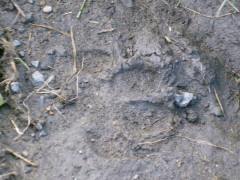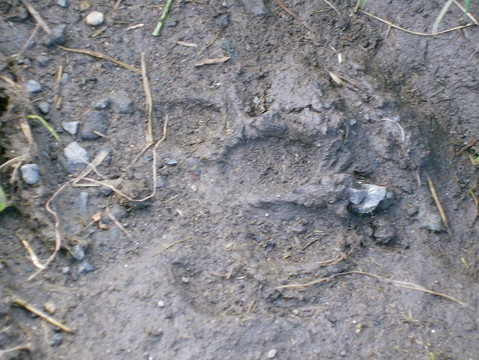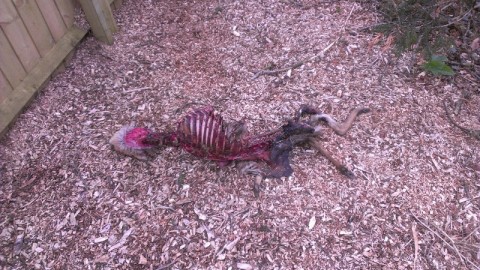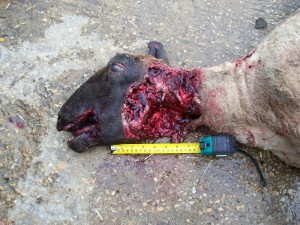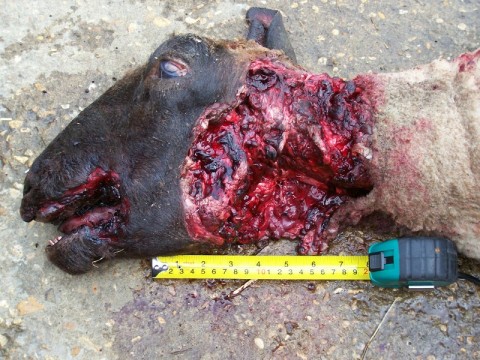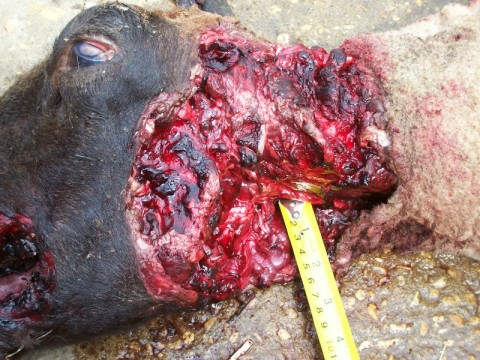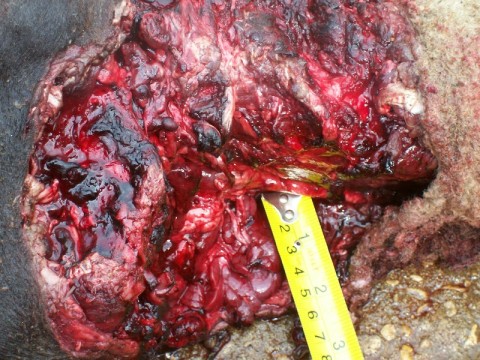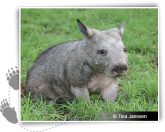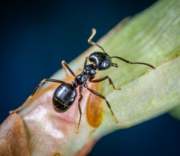
What's New (The Weekend Update)....
Every weekend I will update this section to keep you informed about what's going on here at Big Cats GB regarding; non-native big cats, big cats, big cat sightings & big cat events / predation.
Please note that the Weekend Updates for January - March 2013 (video footage, images and Big Cats GB news) have been moved to a new page & can be accesed by the link to the left of this page or clicking on this link Weekend Updates January - March 2013.
Weekend of 30/31st of June 2013,
Dear Visitor,
I'm afraid I'm not very well this week; 'mans' cold syndrome' and trust me I look far, far worse than this guy. As I don't think I would do a key investigation video presentation justice in my dire life threatening condition I will do a video of key Investingation Two (West Midlands) next week assuming this cold has not done away with me :-)
Please see my Key Investigation One (Wales) to see the type of presentaion I will be undertaking next week.
Regards
Darrell
Weekend Update 22nd/23rd of June 2013.
Dear Visitor,
This week I provide a video commentary of my Key Investigation One (Wales) providing more details on the events. I suggest when you watch the video you have the Key Investigation One (Wales) page open so the commentary makes more sense.
Regards; Darrell
Weekend Update 13th/14th of June 2013.
Dear Visitor,
This week another video update with an anouncement on how I intend to upgrade my Key Investigation pages of the website.
Regards; Darrell
Weekend of 8th/9th of June 2013.
Dear Visitor,
I hope you enjoy the wideo update this week. It's about why I do what I do, how I got started, what happened along the way and where I'm heading!!
Regards, Darrell
Weekend of 1st/2nd of June 2013.
Dear Visitor,
Not much to report this week; this game is like that I'm afraid.
I have had no new reports of sightings/events to tell you about. However, there are some interesting developments in America that echo the introduction of their equivalent of the British Dangerous
Wild Animals Act 1976. Please see my page about the UK act and other reasons why non-native big cats may be in the UK: Why Non-Native Big Cats May Roam the
UK?
The aforementioned act was introduced in the UK to ensure that large predators being kept in private collections had appropriate compounds for their needs. To sum up huge amounts of money would have needed to be spent by private owners of non-native big cats to provide appropriate compounds for their animals. It is suggested that the massive increase of non-native big cat sightings here in the UK was in part due to this legislation; it's surmised that people instead of building such compounds released their 'big cats' into the UK countryside. My research into the evidence of this is sketchy at best but I do have some anecdotal evidence from reliable sources to suggest that this indeed did happen.
Now a similar move is being made by the American government to ensure the correct compounds are to be provided for private collects of 'big cats' in the USA http://thehill.com/business-a-lobbying/302261-bill-to-corral-big-cats-draws-wrath-of-the-circus-industry. Are we going to see a similar rise in non-native big cats in the US after the introduction of this legislation? The possibility is intriguing and only the next few years will tell & if a simmilar patten develops in the USA akin to the UK. If indeed non-native big cat sightings do increase in the US it would provide some indirect support to the notion that the introduction of the Danderous Wild Animas Act 1976 may have in part been responcible for the increased number of 'big cat sightings' here in the UK.
Please see my Why Non-Native Big Cats May Roam the UK? page on the website where I go into this area of the big cat debate in much greater detail than I have here. Inparticular the Modification order to the 1976 Act (which was added some years after it's introduction to the 1976 Act) which made it illegal to realease dangerous animals into the UK countryside.
Some suggest this was like shutting the stable door after the
horse (non-native big cats) had already bolted!!
Regards
Darrell
Weekend of 25th/26th of May 2013.
Dear Visitor,
Today, for my regular viewers and the thousands of new viewers visiting the website this week I am afraid there is no detailed Weekend Update as I have friends up for a few days this weekend.
There will be the update next weekend as usual & I just hope you, and inparticular new viewers of Big Cats GB have the patience to call in next weekend to see what’s been happening here at Big Cats GB in the intervening time. This is my hobby not my work and although I do work hard to keep the site as up to date as possible I still need some time for myself from time to time.
Have a nice bank holiday and hope the weather holds. Next week’s Weekend Update will contain a video-blog from myself at a historic non-native big cat predation location in the UK.
Regards, Darrell.
Weekend of 18th/19th of May 2013.
Dear Visitor,
Today I am going to look in depth at a potential non-native big cat image of a pug [track] mark sent in by a witness. They wish to remain out of public scrutiny but are happy for some details of events to be reported. That image (a larger one of the one to the right) will be presented below after a brief overview of events from one of several emails the witness sent in. I have adapted parts of the witnesses emails to protect their identity:
I'm attaching a photo of a spoor[print] taken last week; I'm not the world's best with a camera and didn't have a tape measure with me at the time. I measured the spoor later and it was
8.2cm across. I also tried to make a casting, but there was a sharp frost and the casting didn't set. We have seen a panther-type animal [black] in our location *********** Scotland and several
other locals have seen a similar animal in the last couple of years…. We have also seen faeces and one night last year the sound of two cats either fighting or perhaps mating; our location is
quite remote and there are no domestic cats within a mile of us in any direction…..We used to have ******* dogs…. and still have a number, including a male who is much bigger than the average male
for this breed. His paw-prints are a similar size, but sank deeper into the mud where I took the pics…... All our dogs spend most of the day on grass, so have very long claws, which, of
course they cannot retract like a cat…..I'd like your opinion as to what might have left this spoor; the toe pads are clearly visible [with no hint of claws] and I could just about make out the
outline of the main/back pad, although it's not too obvious in the photo…..
The images that follow the rest of this analysis show clearly the key aspects of a dog track that are not visible in this image sent in by the witness. These images of dog tracks to come are from Kim A Cabrera a professional animal tracker and I suggest you visit her website: http://www.bear-tracker.com/caninevsfeline.html for more information.
![]()
My opinion is such on the image sent in; the overall shape of the pug [track] indentation is circular not oval as in the dog print images (above & below). There are clearly no claw marks on the witness image which is indicative of cat (whereas claw marks are clearly visible in the dog tracks above and below) & finally there is not a raised ‘X’ of mud running through the centre of the track of the image the witness sent in which is again an indicator of cat not dog. In a dog tracks, prints, pug & spore images thare is near always a raised ‘X’ in the centre of the print as is clearly visible (below & above) in these dog print images.
![]()
So to conclude the witness clearly has a deep knowledge of dogs and feel themselves that this is not a dog track. I too will go out slightly on a limb and suggest that this may be a cat track. Although I would be more certain in that view if more images had been taken and I had seen the track/s in person. Also, I would be more ceratin of this opinion if there was not a ridge of mud that has built up under the upper pads which could have been caused by a forward slip of the animal & thus be a a malformed 'X' raised mud mark typical of dog.
However, with the history of non-native big cat events and ongoing sightings in the area from farmers and landowners I would suggest that this image may be supportive though by no means conclusive evidence that non-native big cats have been in that area.
Again your views are always welcome & thank you once again to witnessess sending in there images and information in the past few weeks.
Regards, Darrell.
Weekend of 11th/12th of May 2013,
Dear Visitor,
This week I have a couple of images for you look at that have been sent into Big Cats GB in the past ten days.
One of the most challenging aspects of what I do is trying to make an assessment of images of possible predation without actually being at the possible predation location. The people sending the images in, justifiably, want my opinions of what they have photographed. The two examples including in the weekend update highlight the difficulties I have in coming to a firm conclusion with the images presented. I will look in greater detail at these two images now.
For the first image below the witness was out for a walk and came across this carcass which they photographed as it was so unusual. They had concerns that a non-native big cat had killed the deer but hoped I would find it was probably fox. After emailing the witness and asking for more details from the witness they stated that there was no signs of dragging, no water or streams in the immediate area but that there was a history of big cat, 'stories' in the area. I wrote back in part saying,
'WOW a very interesting image you sent me!!!!!! I don't suspect big cat though. I think this for a couple of reasons; first there is no indication of how it died; secondly there are remains connecting the ribs. This is important the ribs where I suspect big cat involvement these are always rasped clean, all the way round, of meat….'
Also I would suggest after further thought this week and a detailed investigation of the image is that there are no obvious wound marks and that much of the carcass could have been eaten by scavenging animals and birds hiding any signs of possible predation. I also very much doubt fox would kill a full grown deer.
The second image below also sent in the past ten days is also not conclusive of big cat predation for the same reasons as stated above. It is extremely difficult to assess an image and to determine the true nature of events surrounding the death of the animal. With that in mind my comments below expand further on this observation and provide a few tips on photographing a carcass.
My opinion that these images are probably not big cat predation does not diminish the value and importance of witnesses sending in their images of suspected big cat events. Having access to these images for an investigator provides a good body of evidence that helps inform future enquires by the public.
What I now say is not a criticism at any level of people kind enough to send in their images to Big Cats GB as when I first started investigating near twenty years ago now I used to do exactly the same. Could I just ask one thing of people when they encounter such carcasses? Please take loads of photographs of the carcass from lots of different angles and distances (including the surrounding area). Much evidence can possibly be seen from one angle but not another. Photographs of the area can also highlight clues to a possible cause of death. You can never take enough images and also include a scale object next to the carcass or at the very least take small steps (along the length of the carcass) and count them this can provide a rough guide to the size of the carcass and then a determination can be made as to the size of the animal that has died.
Again a big thank you to the witnesses who sent in these images your time and efforts are always much appreciated by myself.
Regards, Darrell.
Weekend of 4th/5th of May 2013,
Dear Visitor,
I'm afraid I'm away for a few days so I will not be undertaking a Weekend Update this week. However, I have been sent a number of interesting images by visitors to the site of possible non-native big cat predation this week. So for the next Weekend Update of the 11th / 12th of May I will show these images in the update and give you my impressions of them.
Thank you for those people who sent the images in...........& have a great Bank Holiday weekend. Hope the weather holds :-)
Regards
Darrell
Weekend of 27th/28th of April 2013,
Dear Visitor,
This weeks Big Cats GB Weekend Update contains a couple of videos I took in 2009 in a follow up investigation of a location that may have been undergoing non-native big cat predation.
The location was brought to my attention in 2009 by a witness that had seen a large black cat (the size of a large dog) at the side of the road as they were driving past. The next day the witness went for a walk along a public footpath very close to the sighting location and discovered a number of sheep remains. I was asked to investigate that same day and we discovered about another six sheep remains.
These remains were in locations; near streams & marsh land, hidden in cover (over fences away from the field the rest of the sheep were occupying) and showed signs of being predated over a sustained period of time; not scavenged (I do not include these videos as they show images of the witness who does not want their identity to be in the public domain).
We were concerned that as these remains were near to a public footpath we agreed I would approach the police and inform them of our concerns. The police listened but would send no one down to investigate our concerns and findings. Notwithstanding this, I decided for a couple of months to head down each week to the area and see if new remains appeared; none did.
The two videos below show my return to the possible predation area I believe a year later and what I discovered. Although what I found is not conclusive of any non-native big cat involvement the finding of numerous carcasses in various states of decay; all found near streams (importantly one ewe had evacuated it’s bowls at it’s location of death) and in cover leave the slight possibility open that non-native big cats may have been responsible. None of the remains (as you will see) were in a condition that would show wounds that indicate that non-native big cats had killed the animals but the locations they were found in and the historical context does leave this slight possibility open.
The important thing about the videos is the ongoing and inconclusive nature of investigating big cat sightings and events. Nothing in these videos conclusivly prove that big cat predation had possibly returned (although the patten of location of the ewes indicate that this may be the case). However, the videos do show how you need to constantly return to possible predation locations as events may be ongoing.
Oh, I also sorry I said, 'sh@t' in video one but I'm only human.
Please also note that I do not approach the authorities lightly and this in my years of investigating non-native big cat events, sightings & predation, is the only time I have done so. I did this with the permission of the witness and because the events were on a public footpath.
Regards
Darrell
Weekend of 20th/21st of April 2013,
Dear Visitor,
This weeks update will be looking at a case of possible predation I investigated in 2008. I have not included the investigation in my Key Investigations due to the unique nature (in my limited experience) of the shape of the wounds.
I was contacted by a landowner, in the Midlands who had had three ewes killed in the same field, in the same location in the same way over roughly a fifteen day period. The ewes had been killed roughly three or four days apart over this period. The image to the side and those below show the unusual nature of the wounds. All three ewes had been killed mid-field and then dragged to the nearest hedge where they were devoured.
I was called in to investigate after the third ewe was killed and I arrived and took these (and many other images) in the farmers courtyard. Clearly, the wounds show a huge section of the neck removed (the landowner said that the other ewes had the same wounds but had been fully devoured but the landowner did not take any images of this). This ewe had not been devoured and only the neck wounds showed any signs of the attack. The landowner suggested that the predator (of whatever type) may have been disturbed as they had started plowing that morning in the next field). Clearly the ewe had not been their long as the eyes had not been removed by carrion.
What puzzles me is the 'almost man-made' shape of the wound; clearly square in shape!! However, if man had killed this ewe and the others for meat then why were the other ewes killed previously not removed from the scene of the crime & indeed why would man ‘devour’ these previous carcasses on the spot? There was not a portable barbeque set in site!!!!! I showed the farmer images I had of possible ewes killed by big cat predation and he said that the other ewes killed looked similar (the rib cages opened and the meat rasped clean from the bones).
As I have stated I have not come across these type of wounds before in my investigations and as such remains a total mystery to me.
Hope you have a good weekend?
Regards
Darrell
Weekend of 13th/14th of April 2013,
Dear Visitor,
The update this week is about letting you know I have a new page on the website called; A Message To Witnesses (Farmers, Landowners & the General Public). I will leave it to yourselves about having a quick look at what it is about.
With regards to big cat events and sightings reported to me this week I have to say it's been another quiet week. This is quite unusual this time of year as Spring & Autumn tend to be the time that events; particularly possible predation by farmers and landowners get reported to me. However, this could be caused by the extended winter we have encountered and perhaps events may start being reported in the next month or so.
Oh, I must also apologise; I have accidently deleated the Weekend Update of the 6th/7th of April 2013 (the entry below this) sorry about that. I will try and find it and get it posted if I can. Bloody Idiot; me not you :-)
I hope you have had a good Easter and as always I'm happy to answer any questions you have.
Regards, Darrell
Please note that the Weekend Updates for January - March 2013 (video footage, images and Big Cats GB news) have been moved to a new page & can be accesed by the link to the left of this page or clicking on this link Weekend Updates January - March 2013.












